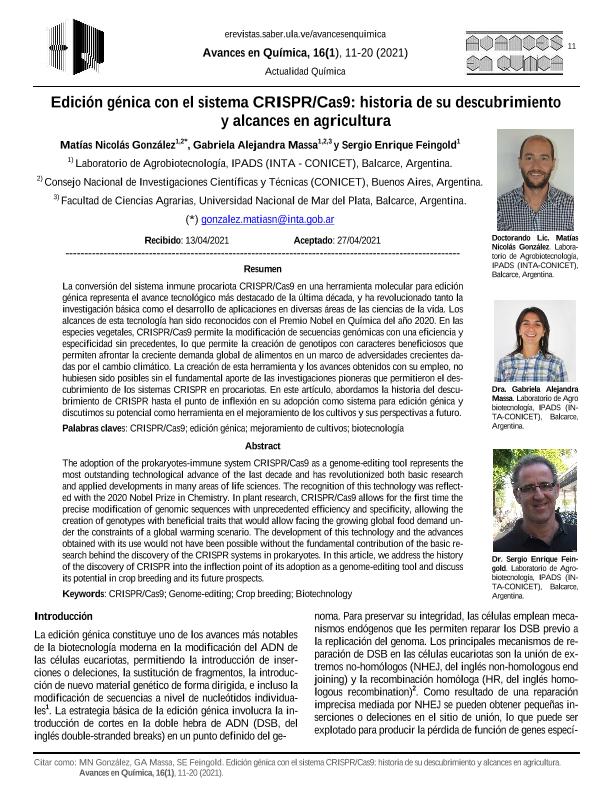Artículo
La conversión del sistema inmune procariota CRISPR/Cas9 en una herramienta molecular para edición génica representa el avance tecnológico más destacado de la última década, y ha revolucionado tanto la investigación básica como el desarrollo de aplicaciones en diversas áreas de las ciencias de la vida. Los alcances de esta tecnología han sido reconocidos con el Premio Nobel en Química del año 2020. En las especies vegetales, CRISPR/Cas9 permite la modificación de secuencias genómicas con una eficiencia y especificidad sin precedentes, lo que permite la creación de genotipos con caracteres beneficiosos que permiten afrontar la creciente demanda global de alimentos en un marco de adversidades crecientes da-das por el cambio climático. La creación de esta herramienta y los avances obtenidos con su empleo, no hubiesen sido posibles sin el fundamental aporte de las investigaciones pioneras que permitieron el descubrimiento de los sistemas CRISPR en procariotas. En este artículo, abordamos la historia del descubrimiento de CRISPR hasta el punto de inflexión en su adopción como sistema para edición génica y discutimos su potencial como herramienta en el mejoramiento de los cultivos y sus perspectivas a futuro. The adoption of the prokaryotes-immune system CRISPR/Cas9 as a genome-editing tool represents the most outstanding technological advance of the last decade and has revolutionized both basic research and applied developments in many areas of life sciences. The recognition of this technology was reflected with the 2020 Nobel Prize in Chemistry. In plant research, CRISPR/Cas9 allows for the first time the precise modification of genomic sequences with unprecedented efficiency and specificity, allowing the creation of genotypes with beneficial traits that would allow facing the growing global food demand under the constraints of a global warming scenario. The development of this technology and the advances obtained with its use would not have been possible without the fundamental contribution of the basic research behind the discovery of the CRISPR systems in prokaryotes. In this article, we address the history of the discovery of CRISPR into the inflection point of its adoption as a genome-editing tool and discuss its potential in crop breeding and its future prospects.
Edición génica con el sistema CRISPR/Cas9: historia de su descubrimiento y alcances en agricultura
Fecha de publicación:
04/2021
Editorial:
Universidad de Los Andes. Departamento de Química
Revista:
Avances en química
ISSN:
1856-5301
Idioma:
Español
Tipo de recurso:
Artículo publicado
Clasificación temática:
Resumen
Palabras clave:
CRISPR/Cas9
,
GENOME-EDITING
,
CROP BREEDING
,
BIOTECHNOLOGY
Archivos asociados
Licencia
Identificadores
Colecciones
Articulos (IPADS BALCARCE)
Articulos de INSTITUTO DE INNOVACIÓN PARA LA PRODUCCIÓN AGROPECUARIA Y EL DESARROLLO SOSTENIBLE
Articulos de INSTITUTO DE INNOVACIÓN PARA LA PRODUCCIÓN AGROPECUARIA Y EL DESARROLLO SOSTENIBLE
Citación
Gonzalez, Matías Nicolás; Massa, Gabriela Alejandra; Feingold, Sergio; Edición génica con el sistema CRISPR/Cas9: historia de su descubrimiento y alcances en agricultura; Universidad de Los Andes. Departamento de Química; Avances en química; 16; 1; 4-2021; 11-20
Compartir




